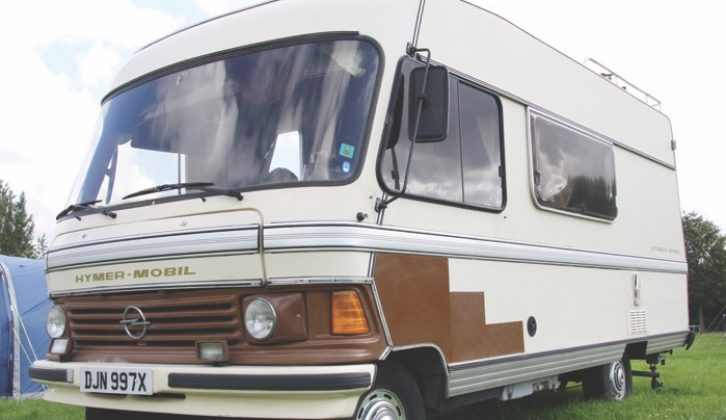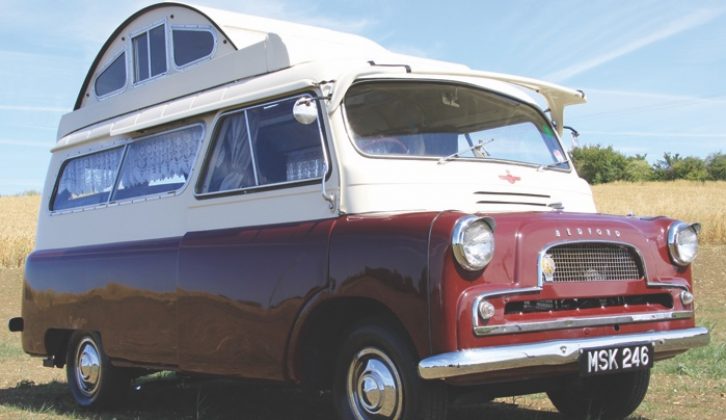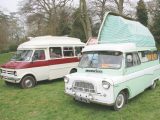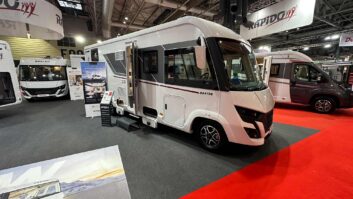Bedford was the commercial arm of Vauxhall Motors, well known for its reliability and military versions of its larger commercials. It also became one of the dominant light commercial manufacturers in the late fifties and early sixties, with the CA model.
During the CA’s 17-year production, it saw only mild design changes – the impressive production figures meant the CB, CD and CE models never progressed from the design board!
Enter the CF
But along came Ford’s replacement for the Thames E4500, the all-new Transit putting Bedford firmly in the shade. With nothing to rival the new winner from the Blue Oval, Bedford turned to its US owners for a ‘quick fix’.
Enter the CF in 1969, radically different from its predecessor, with more than a hint of Chevrolet – for Europe, it was badged as Opel Blitz.
Gone was the hit-and-miss column gearchange for a floor-mount, which did rattle annoyingly as it later wore.
The engine was still mounted halfway into the cab, requiring the removal of the internal cowl for service. And how do I know this?
Well, having learnt to drive in a CA Martin Walter, I left school for a mechanical apprenticeship with a Vauxhall-Bedford main dealership, and went on to purchase several Bedford CF vans or campers.
Take a look in the engine bay and many would have said that the clay mock-up must have melted in the sun – the engine was at a slant! This was to lower the centre of gravity and maintain a low bonnet line – but not the easiest to work on. Then there was the radical toothed rubber cambelt. They said it wouldn’t last, but it did.
Power came from 1599cc petrol and 1760cc diesel, later increased, and standardised again with the 45-degree inclined OHC 1795cc and extremely popular 2279cc.
Models offered were the 106-inch short-wheelbase 14/18/22cwt capacity, with the 126-inch long-wheelbase rated at 25/35cwt twin-rear-wheel. Even the short-wheelbase version was larger than the CA it replaced.
Keen convertors
Needless to say, the new model was a hit with campervan convertors, as was the smaller Bedford HA version of the Viva saloon. Such was the relationship Folkestone-based convertor Martin Walter had with Bedford, the later versions of the CA-based Dormobile Romany and Debonair campers, on the new CF, were unveiled before Vauxhall’s official CF launch.
Other convertors quickly introduced the Bedford CF into their ranges, including Auto-Sleepers (who broke from only using the Commer base), Holdsworth, Autohomes, Canterbury, and Cooper & Griffin.
Coachbuilts followed, such as the Dormobile Land Cruiser, the Bristolian from Welch & Co, the Ci Autohomes Bedouin, European Caravans’ Tourstar, KJ Caravans’ Glendale, Pioneer, and the upmarket Jennings Roadranger.
This was also the era of flat-sided aluminium-skinned bodies on a timber frame, with materials and layouts more akin to caravans. GRP and Styrofoam sandwich construction eventually offered better insulation and comfort.
Time for a facelift
It was 11 years before the CF range was given an external facelift. The all-metal grille was replaced by a black plastic unit, with square tail-lamps and round headlamps set in square silver bezels.
This revamped model is sometimes wrongly referred to as the CF2, but that wasn’t introduced until later in 1984, when only the 1979cc petrol engine was available. But it did now feature front disc brakes, and was badged CF230, CF250, CF280 and CF350.
Now more normal, but unheard of then, an electric CF was also being developed in conjunction with Lucas, although battery technology and cost meant it disappeared fast.
Production of the CF ceased in 1987, after the Bedford van factory became a joint venture with Japanese firm Isuzu, forming IBC vehicles. With the Bedford name dropped, the CF’s successor was the Midi. Despite being restyled in 1989, it never really made any impression on the market.
Campervan fans
Our first camper was a self-build HA, similar to the Dormobile Roma. Our second was a CF-based Cooper-Inca.
The Warwickshire company Cooper & Griffin had a background in high-quality furniture and in my opinion, were the closest in interior furniture quality to Auto-Sleepers.
The traditional twin inward-facing settees with a rear split kitchen worked well, topped by a Sheldon solid-sided GRP raising-roof. This proved ideal for our passion of following DTV Dealer Team Vauxhall super-saloon racing and rallying – in comfort!
But a weekend visit to Luton for the Vauxhall Show changed everything. Here we saw a highly modified Bedford CF in a drag-racing team – they had imported many items from the US.
Soon our Inca was sporting striking custom paintwork, JA Pearce mag-alloy racing wheels and twin headlamps. We updated engine parts as they were introduced on the Vauxhall Victor.
Many awards came our way from Custom and Motorhome Concours d’Elegance shows. We eventually sold the Inca and ordered a new CF-based van, at a cost of £2216.
Over the years, during which time I switched to self-employed work, the CF had numerous interiors and paint jobs, advertising our business; these culminated in a ‘Spacemaker’ roof from Motorhomes International. This gigantic side-hinged roof opened and a bunk slid out over the body line, thus providing two adult bunks and a cab bed for our daughters.
Custom conversions
What might generally be termed customised conversions came from Nomadic Wheels (now MURVI), with stunning versions by trailer caravan company Cavalier Coachman, Cruiser Van Company, Broadland Maximus and Cruise Camp Alto Sport, each with varying success.
In addition, many enthusiasts will no doubt remember the Suntrekker demountable, which, like Dormobile, was available on almost every base vehicle of the time.
I still have very fond memories of those days, and although we are now the owners of a luxurious, modern campervan, with a great deal of ‘bling’ – and power steering – I maintain a keen interest in classic campers and all forms of transport nostalgia!
As for the Bedford, the familiar ‘Griffin’ logo of this famous marque can still be seen, represented in the motorhome field on the Vauxhall Vivaro and Movano.
Useful websites
Find out more at:
www.bedfordenthusiastsclub.com
Now more normal, but unheard of then, an electric CF was also being developed in conjunction with Lucas, although battery technology and cost meant it disappeared fast



























